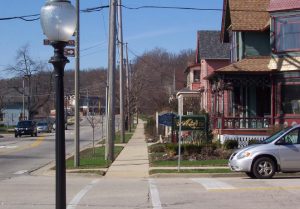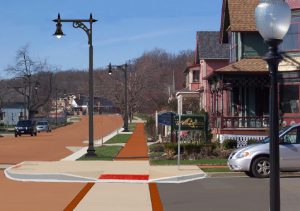New fiscal budget boosts Algonquin downtown plan
Gregory Harutunian for Chronicle Media — April 26, 2017
 dd
dd
Looking south from Washington Street, Main Street (left photo) in Algonquin’s historic downtown district will receive upgrades (right photo) beginning Aug. 1, as part of a $30 million overall renovation plan approved last year. (Photos courtesy of Village of Algonquin)
Infrastructure work on Main Street in Algonquin’s historic downtown district is slated to begin Aug. 1, as approximately $6.3 million was set aside from its Fiscal Year 2018 budget, which was approved unanimously by the Village Board.
The work will entail the replacement of the current water main and sanitary service lines in a precursor salvo to the planned $30 million renovation of the commercial areas.
The effort coincides with an ordinance passed four years earlier that unanimously accepted a concept submission, from Chicago-based Land Visions, Inc., for the best use possibilities of downtown redevelopment. The ordinance also directed those plans to be incorporated into the village’s 5-Year Capital Improvements Program.
“This is just one element, setting the stage with the dressing and the make-up, if you will,” said Russell Farnum, the village’s Community Development Director. “If you build an attractive place, then people will naturally gravitate toward it. We’re building from the ground up, new infrastructure with water and sewer lines, then initiate the landscaping plans.
“We’re working to revitalize the economic platform with the right mix of businesses and events that will benefit the historic downtown district in the long-term,” he said.
The budget was accepted during the April 4 session and shows nearly $49.1 million in overall expenses between the general fund and the operating fund. The general fund should remain balanced at $19 million and includes police, emergency services and village administration costs. The village anticipates revenues of $42 million, although the deficit comes largely from the water and sewer fund, due to the downtown upgrades.
To offset the imbalance, the village will tap into its reserve fund to compensate for nearly $6.6 million in expenditures, and expected revenues of $1.6 million.
“We want to start the infrastructure improvements in late summer, and it will continue for several years,” said Assistant Village Administrator Michael Kumbera. “The$ 6.3 million is coming from several different funds. The entire estimated $30 million cost will be helped when we go out for bids for the infrastructure work and job order. It’s been a favorable bidding climate, and that trend is expected to continue into the future.”
Major revenue streams for the village are the sales tax projections that will range at around the $7.6 million level and is the largest cash source for the general fund budget. The income tax-sharing allotment, computed on a per capita basis of the village’s population is variable and estimated at $3.4 million.
Another funding source is the annual real estate property tax levy, for which the village lowered the collection rate and cited as a fiscal management success, will bring in nearly $6 million.
Infrastructure improvements are also being allayed by the downtown area residing in a tax-increment financing district (TIF), created in 2014, a designation that helps accumulate tax monies collected above a set equalized assessment valuation into a special fund. The TIF district effectively freezes a tax rate on a property for up to 23 years, if the land meets specific criteria such as being unimproved or blighted.
“It’s no secret that the historic downtown took a big hit when the western bypass leg was opened,” said Farnum. “Though it was needed to alleviate the traffic congestion during peak rush hour times, it still cut off the downtown from traffic patterns. Now we want to make it easier for foot traffic to come there.”
Village Manager Tim Schloneger had said the western bypass led Route 31 away from the downtown area and was a critical factor in relieving vehicle congestion. It was important he said that the village took over control of the area, along with plans that would open it foot traffic with easier access to shops and restaurants, while offering aesthetic value.
An engineering plan and survey were developed to bring the village’s downtown vision into reality by Rosemont-based Christopher Burke Engineering Ltd., on a $143,332 contract, with funding used from a set aside in the Algonquin in the 2015-16 operating budget. The Chicago-based Lakota Group was hired to jointly work on the streetscape master plan, undertaken in July 2015.
Talking points for future discussion are the disposition of the Algonquin Road bridge layout, side avenues along Main and Harrison streets, sections with angled and parallel parking, and decorative accoutrements. An archway and remodeled promenade, as well as the re-purposing of existing buildings are planned. Bicycle traffic is being encouraged with furniture rack stations and the wider paths.
“It’s setting the stage, and moving forward,” said Farnum.







